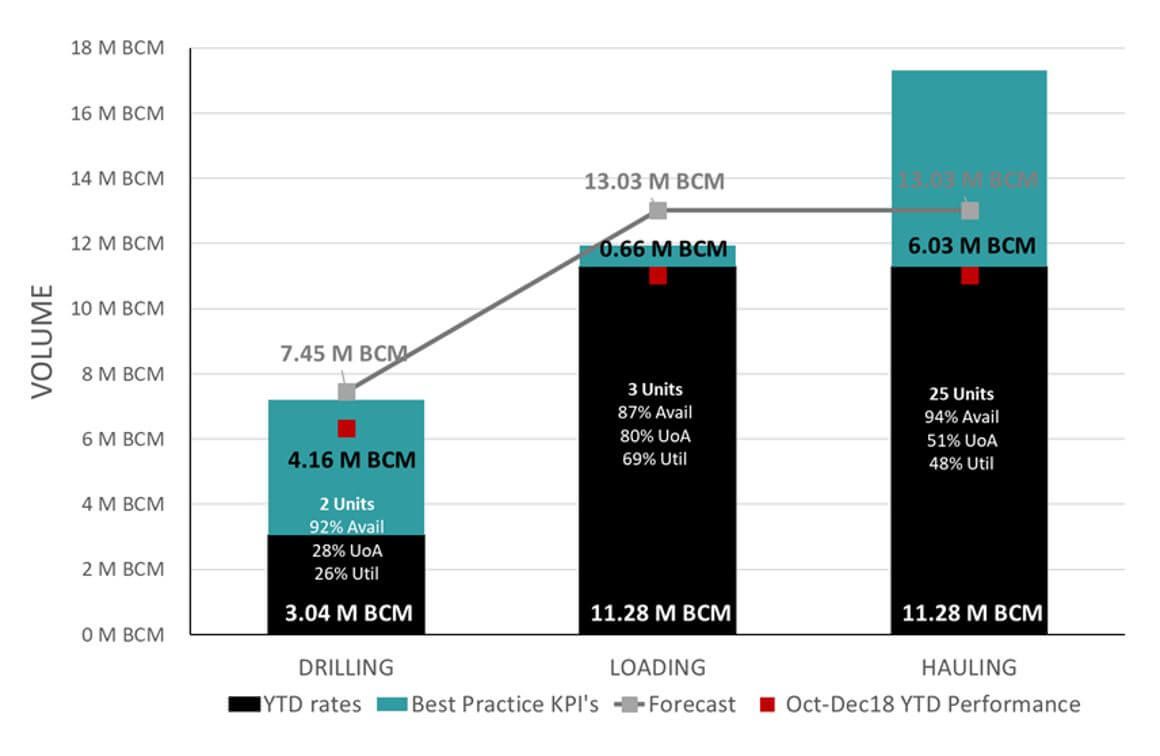Mining Strategy: “Do things better” vs “Do things smarter”
It’s a good thing that Australian companies are throwing the word innovation around to try to change how they operate. The trouble is that, too often, these refer to doing things better rather than doing things smarter.
Innovation generally refers to a business’ ability to generate a stream of new products, services, processes and business models over time that are material to the organization. It can also mean changing the existing processes, or creating more effective processes, products, and ideas. For businesses, this means implementing, creating or improving their status quo, observed through changes in their data streams.
What to do if the status quo is not optimal though? For innovation to matter, it must be material, it must involve a deep understanding of the metrics, especially those affecting the value-carrying parts of the business — core components of the mine’s operating system.
Mining companies understand that innovation is not only about ideas, that it is a resource reallocation problem. This is something companies get wrong consistently. They maintain their resource allocation for years or fail to balance resource allocation towards relieving the constraint. Since these decisions are largely based on guesswork and incomplete data, the result can be costly.
If an organization’s operating system doesn’t allow innovative growth through innovation to occur, it gets stuck doing incremental innovation in products and customer experiences rather than changing its business model.
Introduction
Technology has transformed mines. Anecdotally, 90% of all data in use today was generated in the past two years. Some mines now operate remotely, collecting real-time data, making informed real-time decisions. Others generate and collect all the data at their disposal and must do the best they can with what they have. One thing is certain — there is an immense amount of data recorded. The main objective of data collection is to lead decision-makers to conclusions — if you can measure it you can manage it. Quite often, however, decision-makers do not have much more time than to monitor primary KPIs and focus on trends, deviations, and exceptions. We tend to accept everything we see as true and acceptable.
Benefits are lost if the data is not managed, cleansed and viewed by the decision-maker in a timely manner. Good processes in data management and effective data use are vital to realizing value from technology. Knowing what metrics to observe and having access to industry benchmarks can drive improvement and maintain focus. For the best impact, improvement needs to be focused on high-value areas.
A mine’s potential improvement (delta) is generally expressed as a percentage calculated from production improvement or unit cost reduction. However, this is often flawed due to the unconfirmed assessment of what good looks like.
Define the problem
“In God we trust. All others must bring data.” – W. Edwards Deming, statistician, professor, author, lecturer, and consultant.
Responsible managers within an organization are faced with many situations where they make daily decisions that could have significant impacts on the business. These decisions may seem trivial at the time but how do they compare with the peer group? Are they similar or better? They could add up to average or superior performance.
With increased pressure on mining organizations, situations and decisions become more and more complex:
Without due consideration to what good looks like, a site may continue to operate for years without comparing their practices with peer groups and therefore miss the opportunity to be more productive and more profitable. “The standard you walk past is the standard you set” (Anon) is a popular phrase.
Many mines that are very profitable have prospered in the recent past, yet, still feel insulated as they see disruption as not an issue. They seem to be hoping that they won’t be hit or that they can ride out their term before disruption takes hold.
During Performance Diagnostics AMC often comes across disconnected strategic systems: good orebody understanding, robust five-year plans and annual schedules, but lacking innovation, disconnected spacial compliance, and a distorted view of their own performance.
The Business Improvement starting point is to frame the problem in a clear, defined, measurable way.
Aspects that add to the effectiveness of the problem-framing process are summarized by the questions:
Does the problem statement (business case) link to the high-level business performance metric (KPI)?
- What is the timeframe to completion?
- What is the business impact of the gap? Is the current performance level and expected performance level defined and the difference identified?
- With data in hand and the problem clearly framed, the improvement process can commence.
Data mining
Conventional mining today has become increasingly expensive, as miners reach deeper into the earth to find profitable ore bodies and work further and further away from infrastructure. Every day more and more data are generated to better understand the complexities of mining and to counter the effect of escalating costs by working smarter. To interpret trends and relations from these datasets requires more detailed data mining and analytics (and time). Actionable insights from analytics help mine production managers make decisions when controlling and improving their operations.
The value of monitoring production data is usually well understood — what gets measured, gets managed. Significant investment is often made into fleet management systems (FMS) and integrated production reporting software because they contribute toward better measurement. However, to realize the value potential of these systems often takes ongoing analytical effort, which feeds into a comprehensive and sustained improvement program. Furthermore, to truly achieve performance breakthroughs, the process demands digital innovation, including software to optimize asset utilization, devices to remotely monitor and control activities, and robotics for the automation of repetitive tasks. The benefits of asset optimization tools are obviously significant. However, benefits are lost if the data is not managed, cleansed, and viewed by decision-makers in a timely manner. Good processes in data management and using the data effectively are vital to realizing value.
Manage your data
The complex FMS systems many mine sites use provide a dispatch and control process for mining equipment and capture an immense amount of production and equipment performance data. The data collected is often used within the FMS to determine the most productive routes for haul trucks. There are also many mines that use manual prescribed lists of duty (TALLY, PLOD) cards to collect data, which are then entered into data bases or spreadsheets. Most mines use some form of Management Operating System (MOS) or a commercial reporting system to collate fleet productivity data with other site data.
To achieve a good understanding of a mine’s productivity and efficiencies, a robust validation process is required to ensure data integrity is maintained. Reports representing the correct interpretation of data. From AMC’s observations at mine sites, some common challenges and improvement issues are:
- Collection: FMS not set up adequately, which cause incorrect referencing.
- Collection and interpretation: Time Usage Model not correctly applied or interpreted.
- Validation: Production data not checked, validated and corrected.
- Store: Data storage does not allow data mining.
- Analytics: Insufficient analysis capability, no priority improvement, inadequate potential for improvement and bottom-line impacts identified.
- Interpret: Which production targets are at risk and what actions need to be taken.
- Insufficient improvement programs.
Improvement objective
What to focus on? Where to start? Which tools are available to help with making the most intelligent decision? Bottleneck analysis and Cost Driver Tree analysis are useful visual tools providing insight into current capability, forecasted capability and the delta between expected performance and actual performance. Often improvement initiatives are executed without impacting the bottom line, this is most likely to have occurred outside the bottleneck. The bottleneck study provides a high-level assessment of which value chain component is the bottleneck and the cause.
In the example below, drilling is currently under-performing, however has adequate capability. A detailed process understanding is important, and although the full potential is reached, in this case, the drilling function remains the constraint. Further investigation may also reveal blasting constraint or a significant portion of free-dig. Cost-saving potential exists in the truck fleet and may involve equipment rationalization, targeted maintenance or location restriction — it is a resource reallocation problem. Debottlenecking can be done by improving blasting efficiency (or face availability) and by reducing the trucking resource. The AMC Performance Diagnostic often identifies operations that fail to balance resource allocation as their decisions are largely based on guesswork and incomplete data that lead to costly errors in judgment.
Value realization
Data analysis on AMC’s performance benchmarking data indicates that for the average mine in the industry, 30% productivity improvement is possible in drilling and blasting operations, and 20% productivity improvement in loading and hauling operations. But this improvement gap is relevant to doing things better and not to doing things smarter. The “doing the things better” in the core business — better time utilization, better equipment use, pricing, better customer experience, more incremental products.
The “doing things smarter”, however will have the potential to propel the organization beyond the 20% or 30%, through geomodelling, mine design, technology or other changes in mine parameters. Doing things smarter changes mine design and mine planning processes, changes rosters, equipment, maintenance effectiveness, etc.
Modern technology has provided operations with ample data that can be used to effectively improve productivity and reduce costs. However, unless the data systems are robust, data are validated, and the value proposition is clearly defined, productivity and cost improvement become an elusive task. Using appropriate analytical tools and validated benchmarking data, mine operations are discovering the ability to zoom in on improvement opportunities, prioritize their effort, and realize results. Even mines that operate less sophisticated systems can benefit from a systematic analytical approach, if they have a clear strategy.
The AMC Performance Diagnostic highlights the significant gains to be made across most operations by doing things better and by doing things smarter.
Subscribe for the latest news & events
Contact Details
Useful Links
News & Insights



